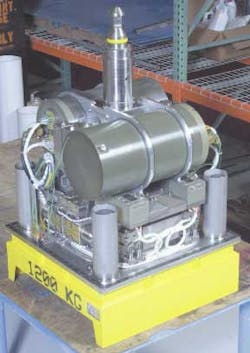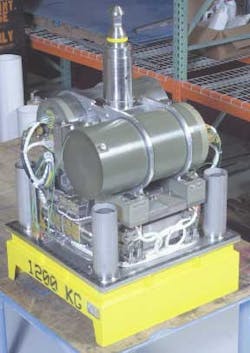SUBSEA TECHNOLOGY: Subsea control modularity allows standardization, improves reliability
Key components to electro-hydraulic subsea controls systems have been standardized by Cameron Controls, so that a variety of reliable units can be combined to build the specific system that fits each application.
The idea of standardization is catching on quickly in the subsea industry. More projects are coming on line as suppliers providing a range of systems see an advantage in standardization. Among the systems that are being approached from a component standpoint are subsea controls systems.
Depending on the size and requirements of a subsea tree, a variety of controls options are needed. Electro-hydraulic control systems provide the highest degree of operability, functionality, and information handling. Cameron Controls' electro-hydraulic system, Camtrol, is an example. John Bodine, Marketing Manager for Cameron Controls, said this modular system uses components, as well as redundancy where analysis shows it is needed. Each standard component incorporates the experiences gained on previous projects.
Need reliability first
Reliability is the key measure in the subsea industry. Nothing wrecks the economics of a subsea project faster than non-productive time (NPT) and the need for unscheduled intervention, especially during the first one to three years of operation.
NPT during this period is referred to as "infant mortality." The need for low NPT historically meant using direct hydraulic control systems. Bodine said the reliability of such a system is unparalleled. It simply transmits a hydraulic signal from topsides to the subsea functions via an umbilical. Very little can go wrong with such a simple system.
The problem is, as subsea projects grew to include more wells, more functions were needed. Operators also required more information from deepwater and remote fields. All these factors increased the requirements of a control system so that the direct hydraulic system was no longer practical.
An electro-hydraulic system, that is, one that transmits an electrical signal from the surface to activate hydraulics on the subsea control module, was the natural successor. Bodine said such a system can handle multiple functions and control numerous wells, responding rapidly to commands from the host facility. If a field requires more than three to four subsea wells or if intelligent completions are needed, Bodine said the electro-hydraulic system is the way to go.
The caveat is that this system requires more subsea equipment, subsea electronics, and subsea electrical connectors. That means there are many more opportunities for the system to fail. Before such a system is put into place extensive testing and qualification is done. This costs money and time for the operator and supplier, but it is essential to improve the chances that nothing goes wrong with the subsea controls system once it is installed.
Standardization
In the past, the design of the electro-hydraulic control system would include a number of equipment pieces and components that might have been used on earlier systems. It didn't matter that a lot of the design components were already in place on other jobs, each new system was designed from the ground up.
This was an expensive and time consuming process, and it could not guarantee high reliability systems, since the deliverable equipment tended to be one-off designs. As control systems became more complex, it became increasingly time consuming and expensive to start fresh each time. While high-intensity engineering and testing of each new system helped ensure reliability, this approach did nothing to address the issue of infant mortality within the electronic or hydraulic systems. Nor did this approach enable fasttrack developments in deepwater or remote locations.
Cameron embraced the concept of production-line component designs as the best, fastest, and most cost-effective approach to reducing infant mortality and improving system reliability. This approach enables equipment, and possibly entire systems, to be simply reconfigured from one development to the next. The systems are reconfigured, not redesigned, Bodine said. The idea is that if a system is designed and qualified outside of project constraints, then a higher reliability solution will result.
Then, based on timely reports from field applications, lessons learned can be incorporated into the system, and into the production line in which identical designs are produced. This allows for refinement of one successful design rather than the "start-from-scratch" approach of the past. Each improvement on what is becoming a standardized design shows up in all future products.
By working from a suite of standardized components, it is possible for Cameron Controls to design a control system for virtually any application. Because they are prequalified, the components ensure higher reliability.
The system is offered in modular blocks that not only ease the initial design for clients, but make changes more convenient, less expensive, and easier to incorporate into the development schedule. In the past, if there were a change order on a system already under construction, it could mean a delay, which was inevitably expensive for the customer.
The company's subsea control modules use a series of identical four-function valve blocks and a simple base plate. This means functionality can be added in one day and the reconfigured design placed back in production in hours, rather than weeks or months, Bodine said. Not only does this allow for changes late in the process, but these standardized blocks are prequalified, so there is a time savings as well.
Redundancy
Bodine said that systems-level thought and analysis went into into design of the system. The goal was to provide improved system integrity, and to incorporate planned redundancy of components where single point failures may occur. Properly monitored, a redundant system allows the operator to identify failures, then schedule and make repairs during planned maintenance operations. This prevents taking production off line, reduces non-productive time, and saves unplanned cost for both the operator and manufacturer.
As subsea projects become more remote, control system requirements increase. Complex field developments require control systems that can transmit more data to and from the host facility, as well as respond rapidly to a variety of commands and changing field conditions.
With more intelligent completions coming online, the systems have to respond to readings from permanent downhole gauges and intelligent devices, as well as monitor subsea tree functions. While these systems can gather data from the well and reservoir, it must be transmitted to the host facility, interpreted, then acted on. The transmission of this data and the actions at the well depend primarily on the reliability of the control system.

